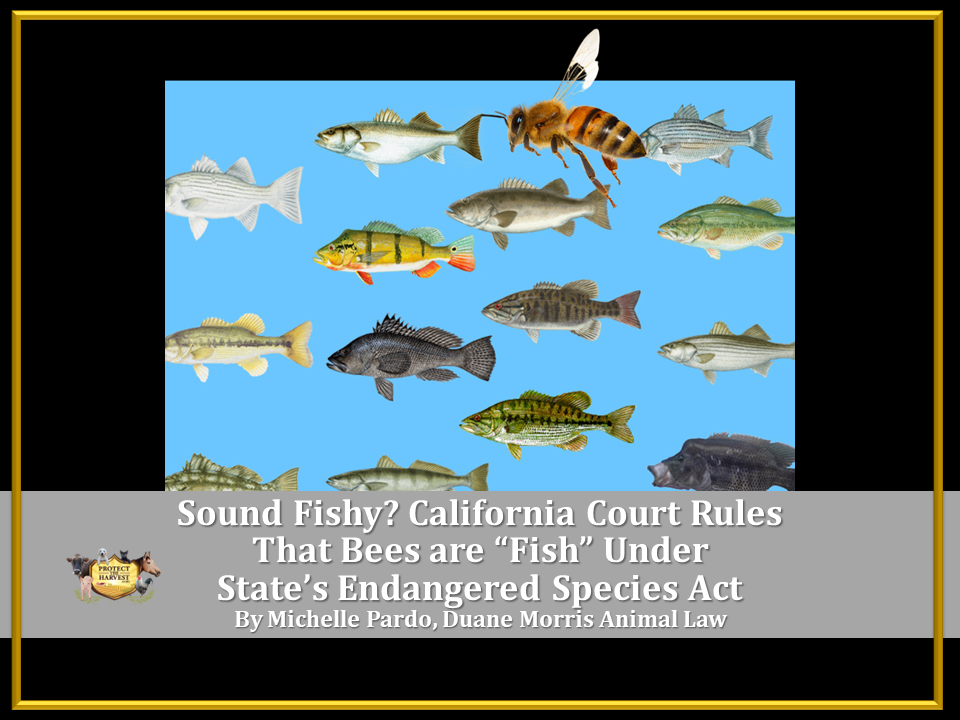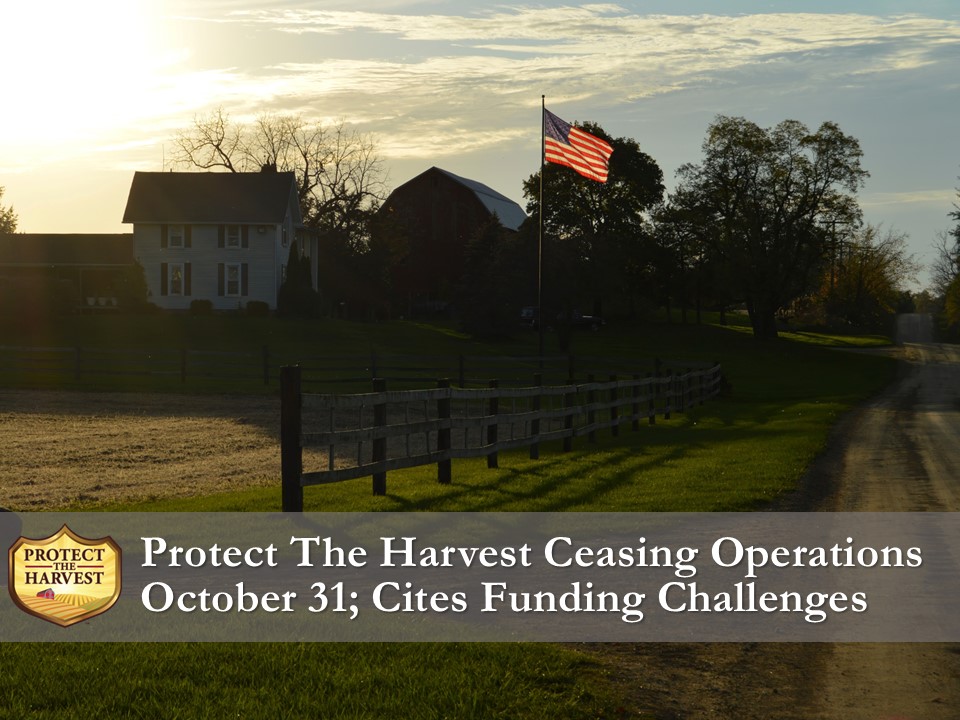
By Michelle Pardo, Duane Morris Animal Law
A California Court of Appeal in Sacramento has created a buzz in ruling that bumblebees can be considered “fish” under the California Endangered Species Act (CESA). This decision reverses a lower court’s ruling that bumblebees – which are terrestrial invertebrates — do not fall within the categories of endangered, threatened or candidate species that the state law protects. The California Endangered Species Act (previously known as the endangered and rare animal legislation) directs the Fish and Game Commission (Commission) to establish a list of endangered and threatened species. Fish & G. Code § 2070. Originally, Section 45 of the CESA defined “fish” as “wild fish, mollusks, or crustaceans, including any part, spawn or ova thereof,” but was amended in 1969 to include invertebrates and amphibians. See Stats. 1969, ch. 689, Section 1. Subsequent amendments made only stylistic changes. See Stats. 2015, ch. 154 § 5.
In 2018, several public interest groups petitioned to list the Crotch bumblebee, the Franklin bumblebee, the Suckley cuckoo bumblebee and the Western bumblebee as endangered under the CESA.
After the Commission designated the four bumblebees as candidate species under consideration for listing as endangered, in 2019 the Almond Alliance of California, and a coalition of growers’ associations and farm and agriculture organizations, filed a petition for writ of administrative mandate, which challenged the Commission’s decision to list the bumblebees, arguing that as terrestrial invertebrates, they did not fall within the definition of protected species and are not birds, mammals, fish, amphibians, reptiles or plants. The trial court granted the writ petition, finding that the Commission had violated its legal duty, was clear legal error, and was an abuse of discretion. The trial court concluded invertebrates were denoted only as connected to a marine habitat, and therefore would not cover insects such as bumblebees.
The Court of Appeal, however delivered a stinging defeat by ruling that bees fall within the definition of “fish” in the CESA. Wait, what? While headlines jeered the “bees are now fish” ruling, a journey through the CESA’s legislative history provides the explanation.
In making its determination, the Court of Appeal noted that the application of definitional Section 45 in the CESA created “textual tension” with the Legislature’s inclusion of amphibians in various sections of the CESA and in the definition of fish. Recognizing that statutory canons are not “infallible,” the Court of Appeal looked to legislative intent. The Court found that legislative history supports the liberal interpretation of “fish” in the CESA:
“Although the term fish is colloquially and commonly understood to refer to aquatic species, the term of art employed by the Legislature in the definition of fish in section 45 is not so limited.”
Opinion, Almond Alliance of California et al. v. Fish and Game Commission (Ct. of Appeal, Sacramento)(C09352) at 2.
But the legislative history behind invertebrates and the CESA has a bit of a tortured past. As it turns out, in 1980, the Commission passed an amendment to the California Code of Regulations to include two butterflies as endangered and one butterfly and a Trinity bristle snail as “rare” (language later amended to “threatened”). For those needing a brush up on critter biology, the Trinity bristle snail is a terrestrial gastropod that is both a mollusk and an invertebrate. After the amendment was submitted to the Office of Administrative Law for approval and publication, it was disapproved because the Office determined that the CESA could not be construed to include “insects” within the definition of “birds, mammals, fish, amphibians or reptiles.”
A 1984 subsequent proposed amendment to the CESA contemplated adding “invertebrates” to the definitions of endangered and threatened species to clarify that they were protected, as well as any species the Commission previously had determined to be endangered or threatened prior to January 1, 1985 (which included invertebrates). Nevertheless, it was removed from the proposed definitions. Why was it left out? The of Department of Fish and Game concluded that sufficient authority already existed to designate invertebrates and that adding the term would be confusing.
In response to a 1998 Assembly member request to clarify whether insects are eligible for listing under the CESA, the Attorney General’s office published an opinion recognizing that insects do not fall within any of CESA’s definitional categories and therefore were not eligible for listing as threatened or endangered species.
So whose interpretation carried the day? While recognizing that formal opinions of the Attorney Generally are normally persuasive authority and entitled to great weight, the court was not persuaded that the Attorney General’s Opinion properly considered the definition section of the CESA. Opinion at 24. The court did find that the Department had a “long history of regulation and management of numerous classes of invertebrates” and indeed, three species of invertebrates already had been designated as endangered or rare (threatened) by the Commission. Id. at 21. The court also relied upon the fact that the Legislature did not act to clarify the CESA after the 2007 California Forestry Association decision (156 Cal. App.4th 1535), which ruled that Section 45’s “fish” definition applied to the endangered and threatened sections of the CESA. “When the legislature amends a statute without changing the statute in response to a prior judicial construction, it is presumed the Legislature knew of the interpretation and acquiesced to it.” Opinion at 22 (citing People v. Blakeley (2000) 23 Cal.4th 82, 89). The inclusion of the snail by the Legislature also was the “hook” that made the Court of Appeal find that a protected “invertebrate” could be of the terrestrial or the aquatic variety.
The Court concluded that the term “fish” was therefore a “term of art” and could encompass species that reach far beyond its colloquial meaning — a rationale that takes a bit of the “sting” out of the seemingly absurd “a bee is now a fish” headlines that followed the decision.
What are the practical effects of this ruling? For the four bumblebee species, it means that mitigation measures and alternatives may need to be considered before certain activities (hunt, pursue, catch, capture, or kill or attempt to undertake these actions) can be undertaken. Exceptions exist, including for acts of “lawful routine agricultural activities.” See Fish & Game Code § 2087 (“accidental take”).
But what of the transportation of bees into California to pollinate almond crops? California is the source of approximately 80% of the world’s almond supply and roughly 80% of all commercial bee colonies in the United States visit California to pollinate almonds. Will this “transport” of an endangered species into and throughout California be considered to be part of the routine agriculture process, require an incidental take permit, or be outright illegal? The practical effect on the California almond industry – which is extremely reliant on bees – may face an uncertain regulatory future.
Michelle Pardo is a member of Protect The Harvest’s Advisory Committee


